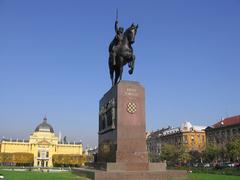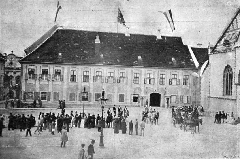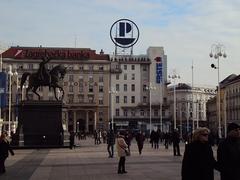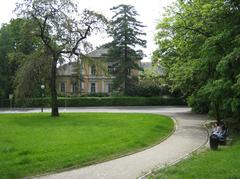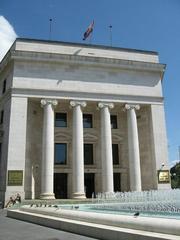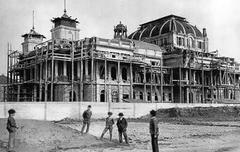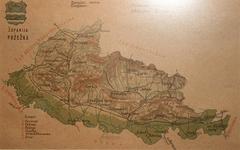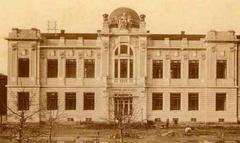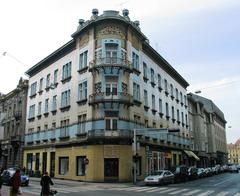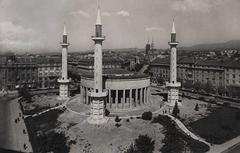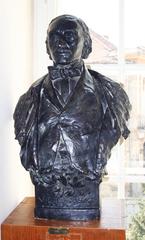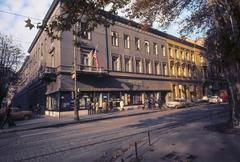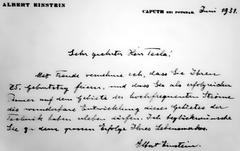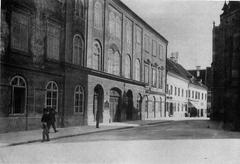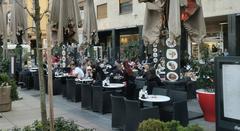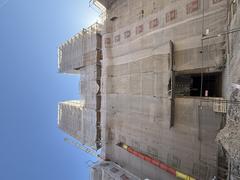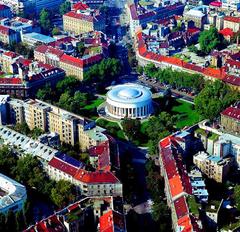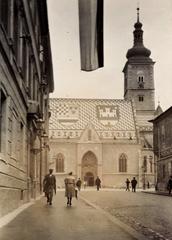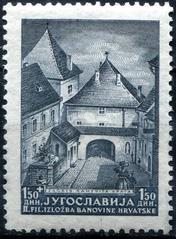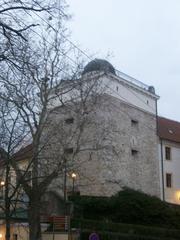Medvedgrad Visiting Hours, Tickets, and Zagreb Historical Sites Guide
Date: 14/06/2025
Introduction
Nestled on the southern slopes of Medvednica Mountain, just north of Zagreb, Medvedgrad is a striking medieval fortress and a symbol of Croatia’s enduring history. Built in the 13th century to defend against Mongol invasions, Medvedgrad has evolved into a cultural and historical landmark, seamlessly blending its medieval origins with modern visitor experiences. Today, it serves as a gateway to both the region’s storied past and the natural beauty of Medvednica Nature Park.
This comprehensive guide details Medvedgrad’s historical significance, practical information for visitors—including opening hours, ticket prices, and accessibility—alongside tips for making the most of your visit. You’ll also find highlights on nearby attractions, special events, and the innovative visitor center. For the latest details, check the Medvedgrad official website, the Medvednica Nature Park site, and visitor insights on Touristlink.
Contents
- Introduction
- History and Cultural Significance
- Medieval Origins and Construction
- Architectural Features and Layout
- Political and Military Importance
- Decline and Restoration
- Visiting Medvedgrad: Practical Information
- Visiting Hours
- Ticket Prices
- Accessibility
- Getting There
- Visitor Experience
- Visitor Centre & Exhibitions
- Family-Friendly Activities
- Amenities and Souvenirs
- Events and Community Engagement
- Outdoor Activities and Nearby Attractions
- Legends and Folklore
- Safety and Visitor Conduct
- FAQ
- Conclusion
- Sources
1. History and Cultural Significance
Medieval Origins and Construction
Medvedgrad was constructed in 1254 under the direction of Bishop Philip of Zagreb, following the devastation of Zagreb by Mongol invaders in 1242. Strategically perched at 593 meters above sea level on Mali Plazur peak, the fortress protected both the ecclesiastical center and surrounding settlements. Its position ensured commanding views over the region and made it a formidable defensive bastion.
Architectural Features and Layout
Spanning roughly 170 meters, Medvedgrad is notable for being one of Croatia’s largest medieval noble courts. Key features include a central palace (palas), defensive walls, towers (including the prominent southern tower, now part of the visitor center), a chapel, and support structures. Built with robust local stone, Medvedgrad was designed to withstand sieges—though it was never directly attacked.
Political and Military Importance
Throughout its history, Medvedgrad changed hands between Croatian and Hungarian rulers, serving as both a military stronghold and administrative center. It played a vital role in the region’s defense and symbolized the spiritual and secular power of its owners.
Decline and Restoration
By the 18th century, changing military technology and political shifts rendered the fortress obsolete, leading to its abandonment. The site deteriorated until restoration efforts began in the late 20th century. A significant revival took place after Croatia’s independence, marked by the installation of the “Oltar domovine” (Altar of the Homeland) in 1994—a national memorial honoring Croatian soldiers. Comprehensive restoration, completed in 2021, has since transformed Medvedgrad into a modern visitor destination, integrating multimedia exhibitions and interactive displays that celebrate both its heritage and natural surroundings.
2. Visiting Medvedgrad: Practical Information
Visiting Hours
- April–October: 9:00 AM – 6:00 PM
- November–March: 9:00 AM – 4:00 PM
- Closed on major holidays and for special events (check the official website for updates).
- Visitor Center: Open Tuesday to Sunday, 09:00–16:00 (last entry at 15:00). Closed Mondays.
Ticket Prices
- Adults: 40 HRK (~5.50 EUR)
- Students/Seniors: 25 HRK (~3.30 EUR)
- Children under 7: Free
- Family and group discounts available
- Tickets can be purchased onsite (cash/card) or online.
Official price list (Croatian)
Accessibility
- By Car: 20–30 minutes drive from central Zagreb; parking available near the Visitor Center.
- By Public Transport: Take a city bus to Šestine or Bliznec, then hike to the fortress (1.5–2 hours via marked trails).
- By Taxi/Ride-Share: Confirm return trip in advance, as pick-up options may be limited.
- Site Accessibility: The Visitor Center is partially accessible, with ramps and wide pathways. Some historic areas have stairs and uneven surfaces. Contact the Visitor Center for detailed information.
3. Visitor Experience
Visitor Centre & Exhibitions
Medvedgrad’s newly restored Visitor Centre offers engaging displays on the fortress’s history and the biodiversity of Medvednica. The permanent exhibition, “Secrets of the Ancient Mountain,” uses tactile displays, multimedia projections, and hands-on activities to bring medieval life to the present. The center features:
- Bilingual exhibits (Croatian and English)
- Interactive fortress model with video projection
- Thematic rooms on daily medieval life and natural history
- An interactive timeline and digital recipe book
Family-Friendly Activities
- Shadow theatre performances
- Medieval pantry explorations
- Educational workshops for children and families
- Digital and hands-on exhibits to engage visitors of all ages
Amenities and Souvenirs
- Modern restrooms and seating areas
- Souvenir shop with local crafts and memorabilia
- Informational materials and audio guides (Croatian and English)
- Staff fluent in multiple languages
4. Events and Community Engagement
Medvedgrad is a vibrant cultural hub with activities throughout the year:
- Medvedgrad Music Evenings (July): Open-air concerts with panoramic night views of Zagreb (PP Medvednica)
- Medieval Days Festival (October): Reenactments, workshops, and family activities (Medvedgrad.hr)
- Brundanje Festival: Local music, performances, and crafts (AllEvents.in)
- Educational Programs: Conservation and medieval history courses for all ages
5. Outdoor Activities and Nearby Attractions
- Hiking: Over 70 interconnected trails lead to and from Medvedgrad (Medvedgrad.hr)
- Cycling: 100 km of cycling paths; e-bike rentals available at the fortress
- Nearby Sites: Zrinski Mine and Veternica Cave (bats, open seasonally)
- Other Zagreb Parks: Maksimir Park, Jarun Lake, Bundek City Park
6. Legends and Folklore
Medvedgrad is steeped in legends, including tales of the “Crna kraljica” (Black Queen), witches, fairies, and talking ravens. The fortress’s name (“medvjed” means bear in Croatian) reflects both local wildlife and myth, and interactive exhibits bring these stories to life for visitors.
7. Safety and Visitor Conduct
- Weather: Mountain weather can change rapidly; dress in layers and wear sturdy shoes.
- Wildlife: Respect local flora and fauna; do not pick plants or disturb animals.
- Rules: Stay on marked paths and avoid restricted or dangerous areas.
- Emergencies: Contact park staff or dial 112 (Croatian emergency number).
8. Frequently Asked Questions (FAQ)
Q: What are Medvedgrad’s visiting hours?
A: April–October, 9:00–18:00; November–March, 9:00–16:00; Visitor Center closed on Mondays.
Q: How much are tickets?
A: Adults 40 HRK, students/seniors 25 HRK, children under 7 free; family and group discounts apply.
Q: Is the fortress accessible?
A: Partially—ramps and wide pathways are available, but some historic areas have stairs and uneven terrain.
Q: How can I get there from Zagreb?
A: By car, taxi, ride-share, or public transport plus hiking from Šestine or Bliznec.
Q: Are there guided tours?
A: Yes, daily at 11:00 and 14:00, with group tours requiring advance notice.
Q: What events take place at Medvedgrad?
A: Annual music evenings, medieval festivals, and educational workshops.
9. Practical Tips
- Language: Staff speak English and Croatian.
- Best Time to Visit: Spring and autumn for mild weather; summer evenings for concerts.
- Duration: Plan 2–3 hours for a full visit; longer if hiking or attending events.
- Souvenirs: Available at the Visitor Center shop.
- Refreshments: Limited onsite; more options at nearby mountain lodges.
- Visuals: For maps and galleries, see the Medvedgrad official website.
10. Conclusion
Medvedgrad offers a unique blend of medieval history, cultural events, and natural beauty, making it a standout destination among Zagreb’s historical sites. With accessible visiting hours, affordable tickets, and a wealth of engaging activities, it caters to all ages and interests. Whether you’re seeking adventure, education, or reflection, Medvedgrad’s panoramic views, interactive exhibitions, and vibrant festivals promise a memorable experience.
For the most up-to-date information, check the official Medvedgrad website, and enhance your visit with the Audiala mobile app for guided audio tours and travel tips. Explore related articles on Zagreb’s historical sites and hiking trails for a deeper dive into the region’s rich heritage.
Sources and Further Reading
- Medvedgrad Visiting Hours, Tickets, and History: A Guide to Zagreb’s Medieval Fortress, 2025, Touristlink (Touristlink)
- Medvedgrad Visiting Hours, Tickets, and Historical Significance in Zagreb, 2025, Touristlink (Touristlink)
- Visitor Experience, 2025, Medvedgrad Visitor Centre (Medvedgrad.hr)
- Medvedgrad Visiting Hours, Tickets, and Guide to Zagreb’s Historic Fortress, 2025, Medvedgrad.hr (Medvedgrad.hr)
- Medvedgrad Visitor Information, 2025, Nature Park Medvednica (PP Medvednica)

